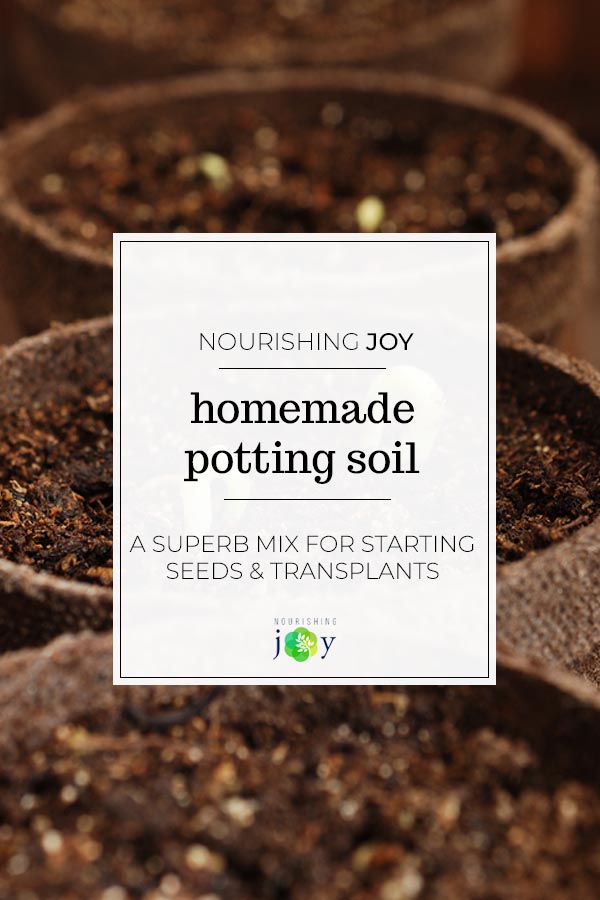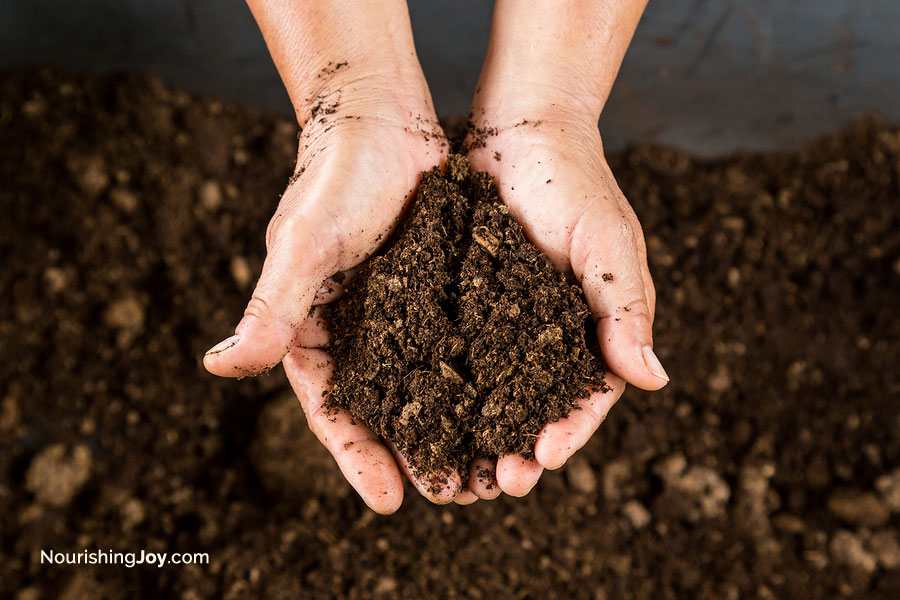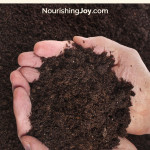Homemade Potting Soil: How to Make Potting Soil Mix
This post may contain affiliate links, including those from Amazon.com, which means we earn a small commission off your purchases. And here's the thing: We only mention services and products that we think are truly worth your attention, whether they're free, paid, or otherwise. This site relies on YOUR trust, so if we don't stand behind a product 110%, it's not mentioned. Period.



We here at Nourishing Joy are all about making life simpler, more joy-filled, and more sustainable. That, and we love good food. 🙂
Thus, we're most certainly passionate about eating vibrantly nourishing food that is inexpensive and easy to source – which often means growing at least some of your own food, even if that just means growing a few herbs on your kitchen counter.
So no matter why you want to make your own potting soil, this homemade potting soil will certainly provide for what you need!
First Things First: Why Use Potting Soil?
Soil is the heartbeat, the food, and the home of the plant, so it needs to be good – no, make that great. I've killed many a plant because I didn't give it a good home, quite literally. My husband has taught me a few things since then, thank goodness. 🙂
And interestingly enough, there is no soil in potting soil – even the store-bought stuff. It's better called “potting mix.”
Potting soil was invented because industrial growers found they needed to be able to start plants in individual containers. However, when a plant is in those conditions, it dries out very quickly and needs to be watered at least once a day. Regular top soil tends to clump or compact in those conditions, which constricts root growth and doesn't allow water to get to the plant. Thus, this mix was developed.
So, why should YOU use potting soil when you're not growing industrially? For pretty much the same reasons:
1. Proper drainage: Whether you're planting starts to transplant later or container gardening on your balcony, if you're using containers, you must have a soil that is porous and fluffy enough to allow for proper drainage. A good potting soil will allow excess water to drain starting within 5-10 seconds.
2. Proper retaining of water: While you want good drainage, you also don't want the water to just run through and not nourish your plants. Thus, you need a soil that will also hold moisture between waterings.
3. Uninhibited growth: Potting soil is typically free from weeds, pests (such as worm eggs) and pesticides. The last thing you want with a freshly planted seed or a newly germinated plant is to have to contend with munchy worms or weed seeds that germinate at the same time. Also, if you're growing vegetables – especially root vegetables when the part you'll eat is in direct contact with the soil – you absolutely don't want pesticides or other substances on your food.
4. Allows for proper root growth. As roots grow, they need freedom to expand as desired without being constricted or rotting. A light, airy medium allows for this.
5. Provides an anchor. As your plant grows, the planting medium should be free-flowing enough that it fills in and surrounds the roots to provide a solid anchor as the plant grows.
How to Make Homemade Potting Soil
To make homemade potting mix, mix in equal parts:
- vermiculite (or perlite)
- peat moss (or coconut coir)
- high-quality finished compost (or worm castings)
If using your homemade potting soil for succulents or cacti, add a quarter-part of sand as well.
Combine and mix all the ingredients in a large Rubbermaid-style tub until the mixture is homogeneous. Store with its lid on for up to six months.
To make a large quantity of homemade potting soil, spread out a large tarp and dump the ingredients in the middle. With two people, lift one side of the tarp at a time so the ingredients tumble around without spilling off. Continue until the mixture is homogenous.
If you can't find what you need locally, here are a few good options:
- Click to find vermiculite.
- Click to find perlite.
- Click to find peat moss.
- Click to find coconut coir.
- Click to find finished compost or make your own.
- Click to find worm castings.
Homemade potting soil can be used in any way you would use store-bought potting soil.
Tell us: what do plant using potting soil? Do you do container gardening? Or square-foot gardening? Do you make your own compost or have a worm farm for the castings?
How to Make Homemade Potting Soil
Ingredients
To make homemade potting mix, combine:
- 1 part vermiculite, or perlite
- 1 part peat moss, or coconut coir
- 1 part high-quality finished compost, or worm castings
If using your homemade potting soil for succulents or cacti, add:
- ¼ part sand
Instructions
- Combine and mix all the ingredients in a large Rubbermaid-style tub until the mixture is homogeneous. Store with its lid on for up to six months.
- To mix a large quantity of homemade potting soil, spread out a large tarp and dump the ingredients in the middle. With two people, lift one side of the tarp at a time so the ingredients tumble around without spilling off. Continue until the mixture is homogenous.
Notes
- Click to find vermiculite.
- Click to find perlite.
- Click to find peat moss.
- Click to find coconut coir.
- Click to find finished compost or make your own.
- Click to find worm castings.







Planning to grow tomatoes & peppers this year can I use this mixture now or does it have to sit for 6 months?
It can be used as soon as you’ve mixed it – definitely! 🙂
Happy planting!